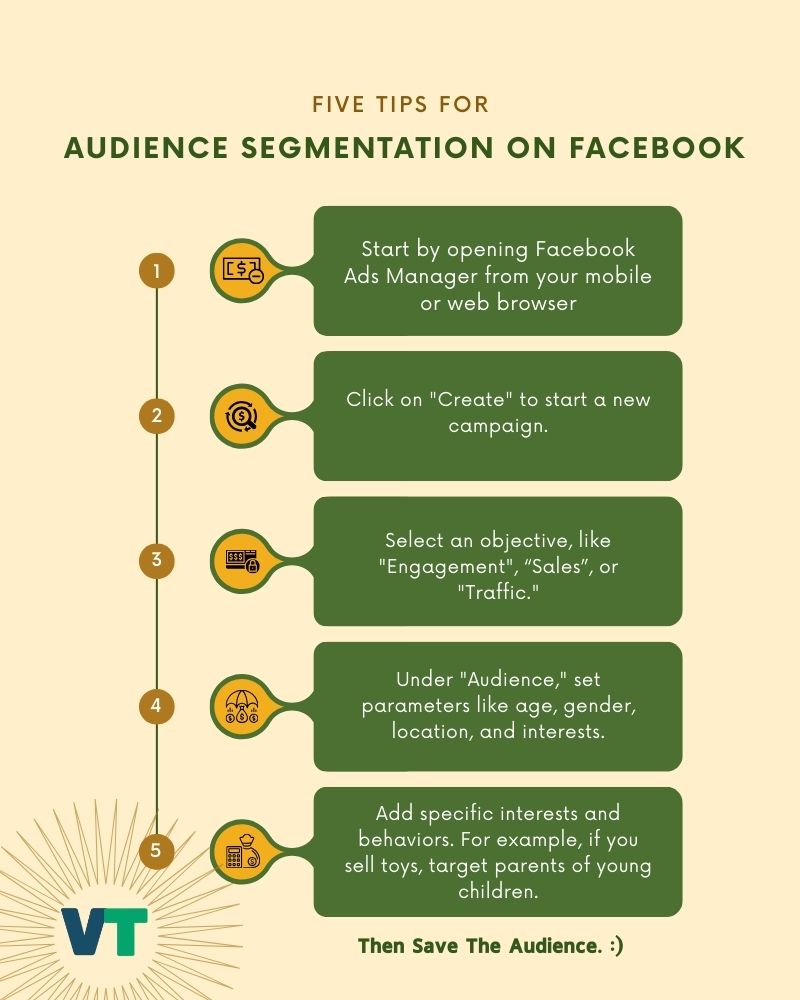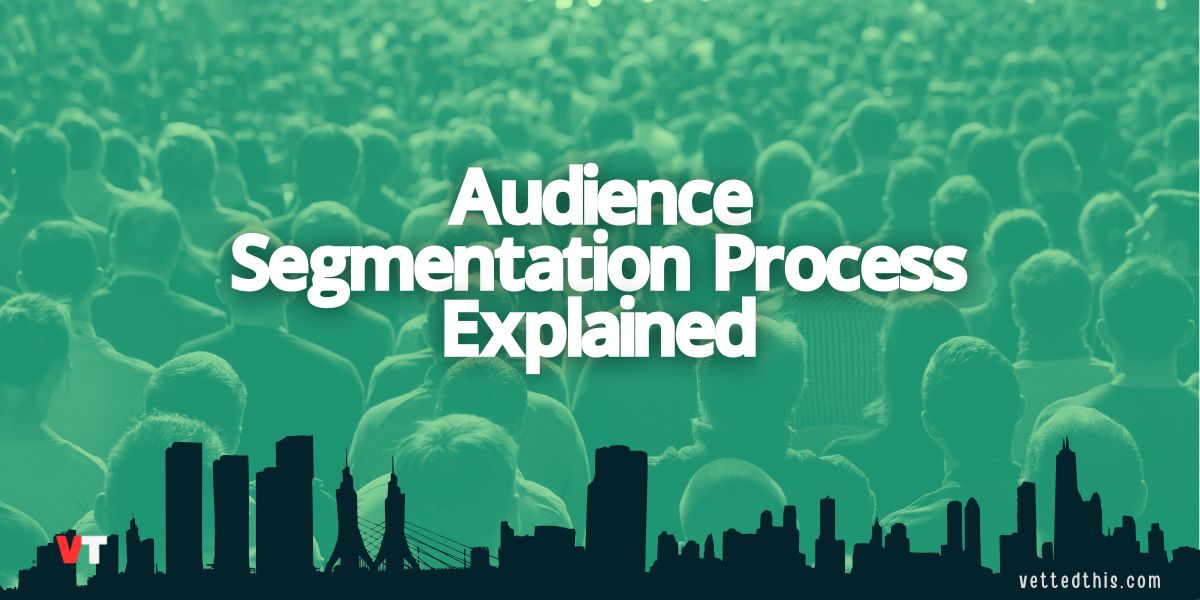To segment your audience (people or customers), you need to split a large group of people into smaller groups based on what they like, where they live, how old they are, their interest, how they shop, what devices they use and what they do online (or even offline).
Think of it like sorting candy into different jars – you might put all the chocolate in one jar, gummy bears in another, and lollipops in a third jar.
This helps you create messages and offers that are more relevant to each group, making your marketing more effective and personal.
How To Do Audience Segmentations (Key steps)?
- Know Your Goals: Imagine you’re planning a birthday party. First, you need to decide what kind of party you want (like a sports party or a movie night). Your goal will impact the future steps a lot because the audience or customers will be varied based on your campaign (marketing, sales, engagement or whatever you want to do) objectives a lot.
- Gather Information: Just like collecting RSVPs for your party, you need to learn about the people you want to reach. For example, if you have a YouTube channel about science experiments, your audience might be teenagers/students who love science. For your science channel, you might find that most viewers are between 13–19 years old, live in cities, and love hands-on activities.
But you have to gather that information first. To do that – you may take help from Facebook’s audience insights, Facebook Ads Library, Pinterest Analytics and Trends and so on.
- Group Similar People: It may look like putting friends who love soccer in one team and friends who love art in another group. Based on our examples above, you could have segments like “kids in cities who love hands-on science” and “kids in rural areas who prefer watching experiments.” A zoo can group visitors who love reptiles separately from those who prefer birds. You can also group people who like Fox News and you can have another group of people who like CNN.
I can give you countless examples like above – but you got the idea, right?
- Create Special Messages/Contents: Write different invitations for different groups – maybe emoji-filled texts for your tech-savvy friends and colorful cards for your artistic friends. For city kids, you might create DIY experiment videos, while for rural kids, you could focus on visual demonstrations.
- Test and Adjust: Keep track of how your segments respond to your content and make adjustments as needed. If city kids love the DIY videos, make more of those. Even if you see the rural kids are watching more DIY experiment videos and the numbers of rural kids are higher than the city kids then make more of these. I mean, you should be making more DIY videos for rural audience, because your test has showed you this data and you should adjust the campaign based on this information to get better result. This is the power of Audience segmentation!
Platform-centric Audience Segmentation

Step by Step Audience Segmentation Guideline For Facebook
- Go to Ads Manager: Start by opening Facebook Ads Manager.
- Create a Campaign: Click on “Create” to start a new campaign.
- Choose Your Objective: Select an objective, like “Engagement”, “Sales”, or “Traffic.”
- Define Your Audience: Under “Audience,” set parameters like age, gender, location, and interests.
- Use Detailed Targeting: Add specific interests and behaviors. For example, if you sell toys, target parents of young children.
- Save Your Audience: Save the audience for future use and click “Next” to continue with your campaign.
- You can set Pixels to distinguish your platform (device, websites) based platform too, which we will talk about later on VettedThis.
Step by Step Audience Segmentation Guideline For Google
- Open Google Ads: Log in to your Google Ads account.
- Create a New Campaign: Click on “New Campaign.”
- Choose Your Campaign Goal: Select a goal such as “Sales” or “Website Traffic.”
- Define Your Audience: Set demographics like age, gender, and location.
- Add Interests and Behaviors: Use “Audience Segments” to include specific interests and behaviors.
- Save and Launch: Review your settings, save the audience, and launch your campaign.
Step by Step Audience Segmentation Guideline For TikTok
- Open TikTok Ads Manager: Log in to TikTok Ads Manager.
- Create a Campaign: Click “Create” to start a new campaign.
- Set Campaign Objective: Choose an objective like “App Install” or “Traffic.”
- Select Audience: Define demographics, interests, and behaviors.
- Use Custom Audiences: Upload your own audience data if you have any.
- Save and Proceed: Save your audience settings and proceed with your ad creation.
Step by Step Audience Segmentation Guideline For LinkedIn
- Open LinkedIn Campaign Manager: Log in to LinkedIn Campaign Manager.
- Create a Campaign: Click on “Create Campaign.”
- Choose Objective: Select an objective like “Website Visits” or “Engagement.”
- Set Audience Parameters: Define your audience based on job title, industry, and location.
- Use LinkedIn’s Targeting Options: Include specific company names or professional groups.
- Save and Launch: Save the audience and launch your campaign.
Step by Step Audience Segmentation Guideline For X (Twitter)
- Open Twitter Ads Manager: Log in to Twitter Ads Manager.
- Create a Campaign: Click “Create Campaign.”
- Set Campaign Objective: Choose an objective like “Followers” or “Engagement.”
- Define Your Audience: Set demographics, interests, and behaviors.
- Use Keywords and Followers: Target users based on keywords and the followers of specific accounts.
- Save and Start: Save your audience and start your campaign.
Types, Methods & Examples of Audience Segmentations
1. Demographic Segmentation
Group your audience or customers by:
- Age
- Gender
- Grade level
- Family size
Example: A toy company targeting kids aged 6-12 with different toys for boys and girls. Or, a shoe brand might target teenagers for trendy sneakers.
2. Geographic Segmentation
Group people/audience/customers by:
- City or town
- Climate
- Urban or rural areas
- School district
Example: A ski resort targets people living in snowy regions. Or, a clothing brand promoting winter coats in colder regions and summer outfits in warmer areas.
3. Psychographic Segmentation
Group people/audience/customers by:
- Hobbies
- Favorite activities
- Values and beliefs
- Personality traits
Example: A fitness brand targeting health-conscious individuals who love outdoor activities or a health food store targets fitness enthusiasts.
4. Behavioral Segmentation
Group people/audience/customers by:
- How often they play video games
- What sports they play
- When they do homework
- Their study habits
Example: An online store offering discounts to frequent buyers or new users, or a streaming service target people who watch mystery shows.
5. Technographic Segmentation
Group people/audience/customers by:
- Devices they use
- Apps they love
- Gaming consoles they own
- Internet usage
Example: A software company targeting users who prefer Android devices or a gaming company targets players using VR headsets.
6. Lifecycle Segmentation
Group people/audience/customers by:
- New student
- Team captain
- Club member
- Graduate
Example: A subscription service offering special deals to new sign-ups and re-engagement emails to inactive users or a coffee shop offers discounts to first-time visitors.
Powerful Audience/Customer Segmentation Tools
There are a lot of free and paid audience segmentation tools out there. Let’s explore some popular but powerful tools that use almost daily.
- Google Analytics
- Free to use
- Shows website visitors
- Easy-to-understand reports
- Facebook Insights
- Built into Facebook
- Shows who likes your page
- Tracks engagement
- Mailchimp
- Good for email lists
- Easy to use
- Has a free version
- HubSpot
- Combines marketing, sales, and customer insights.
Easy to use
Expensive for small businesses or startups.
- Combines marketing, sales, and customer insights.
Benefits of Audience Segmentation
I have personally tested a lot of segmentations on Facebook this year. Surprisingly, I got a lot of views/likes/comments from the general audience but found a very few conversions on the unsegmented or non-targeted audience (cost per click is way low) though there were huge budgets allocated. In another test, I was getting almost 40% conversion rate on a targeted (pixel installed) audience with the right message though the cost per click was higher.
This is the power of Audience segmentations. In offline marketing channels, audience segmentation works really well too.
Let’s see how it can benefit us:
- Better Communication
- Like speaking the same language as your friends.
- Messages that make sense to each group.
- More people understand what you’re saying.
- Saves Time
- Find the right people faster
- Don’t waste time on wrong groups
- More efficient planning
- Better Results
- Like giving the right present to the right friend. You will surely know that your friend is going to like it before you even buy the presents/gifts. That is the power of right audience segmentation. 🙂
- More people respond positively
- Better connections with each group
Key Considerations for Audience Segmentation
- Accuracy: Ensure your data is accurate and up-to-date.
- Relevance: Choose segmentation criteria that are relevant to your marketing goals. That is why I prioritized Goal Setting at the very first step of the audience segmentation process above.
- Scalability: Make sure your segmentation strategy can grow with your business. Make sure the pixel is working on your website or app, all the time.
- Privacy: Respect customer privacy and comply with data protection regulations. This is very important in 2025. As people are more concerned about their privacy, you should always use a disclaimer on your website (on the footer) about what type of data you are collecting and for how many days.



